Heading out the door? Read this article on the new Outside+ app available now on iOS devices for members! Download the app.
As a yogi, you can learn a lot about your fears through your practice. Think about the first few times you practiced going upside down in Headstand or Handstand, or even when your teacher asked you to hold Chair Pose longer than what felt comfortable for you.
The good news? Facing your fears on the mat can help you feel prepared when you face fears off the mat. By getting to know your nervous system, you can learn how to find a steady and comfortable seat anywhere—whether it’s at the gate before you board, in your seat during turbulence, or before you land.
See also 9 Travel Hacks to Help You Find More Zen (Really!) on Your Next Flight
Try this 5-pose sequence to calm any nervous energy you might have before flying:
Easy Pose (Sukhasana)
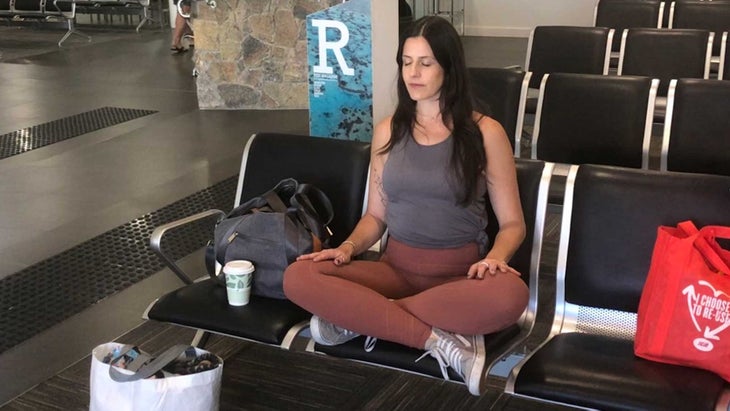
It is very helpful to feel grounded before you fly. If you’re anxious, you’re not in the present moment: You’re worrying about what is going to happen versus what is happening. Practicing this simple seated posture before flying will help to anchor you in the present. What’s more, you can return to this pose this posture any time to feel safe and calm.
How-to: From a seated position, cross your legs so that your right shin is in front of your left. Flex your ankles strongly and rest your knees on your feet. (If you’re seated in a cramped place and can’t place your knees wide, simply cross your shins.) Place your palms down onto your thighs so the heaviness of your hands can cultivate a sense of grounding and the weight of your arms releases any tension in your shoulders and neck. Keep your chest lifted and breathe deeply, then close your eyes and focus your attention on the feeling of solid ground beneath you. Recite the mantra, “I am safe,” silently to yourself 10 times, then switch the cross of your legs and repeat.
See also 5 Poses to Practice in a Cramped Airplane Seat
Extended Side Angle Pose (Utthita Parsvakonasana)
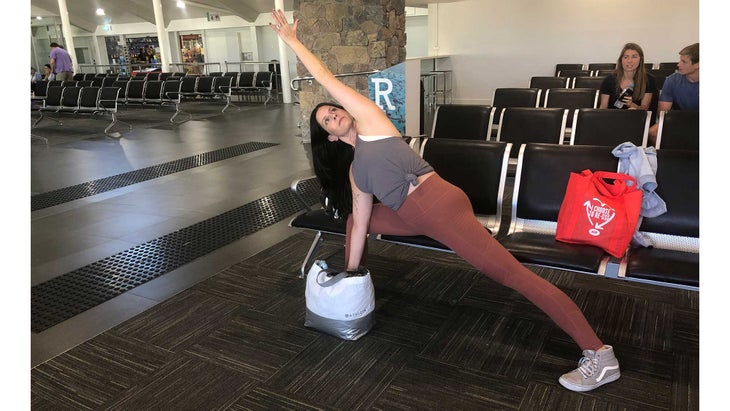
This standing pose has numerous benefits: It strengthens your legs, which shows you your innate power, and this arm variation (with your arm and leg squeezing together) creates a feeling of being held and supported.
How-to: Step your feet out wide and turn your right leg out from within your hip socket and turn your back foot in slightly, aligning your feet heel to heel. On an inhalation, reach your arms out to each side; on an exhalation, bend your front knee to 90 degrees, coming into Warrior II (Virabhadrasana II). On an inhalation, reach your right arm forward, shifting your pelvis and torso over your front leg. For this variation, have your right arm and hand on the inside of your front leg so you can hold your ankle and avoid touching the floor. Squeeze your upper arm and inner thigh together as you reach your top arm overhead to lengthen your spine. Stay here for 15-20 deep breaths, then repeat on the second side.
See also Yoga at the Airport: 5 Poses for a Long Layover
Tree Pose (Vrksasana)
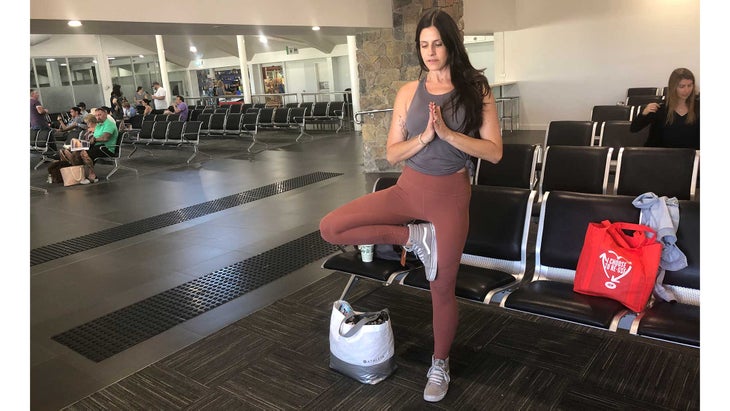
It may seem counterintuitive to do a balance pose when you’re looking to anchor, but this posture can be a real-time training ground for learning about how your nervous system responds when you’re startled. Remember that your practice is not about never feeling scared (or angry, happy, sad, you get the drift). Rather, it’s about how aware we are of what we are feeling—and how quickly we can return to calm.
How-to: Begin in Mountain Pose (Tadasana) with your feet together and firmly rooted into the floor. Pick up your right leg, bend your knee, and turn your thigh out, placing your right foot above or below your knee. Find a steady gazing point in front of you with your hands in prayer at your chest. If you are comfortable, straighten your arms and reach them overhead. If you are still feeling comfortable, trying to look up to your palms. And if you are still comfortable, close your eyes. Be less concerned with balancing perfectly and instead, allow yourself to waiver and wobble. Notice what you are aware of when you feel startled and, in those moments, practice reminding yourself that you are safe. Stay here for 15-20 breaths, then switch sides, taking a few moments with both feet on the floor before switching sides.
See also 5 Poses to Inspire More Self-Love, Less Self Smack-Talk
Low Lunge (Anjaneyasana)
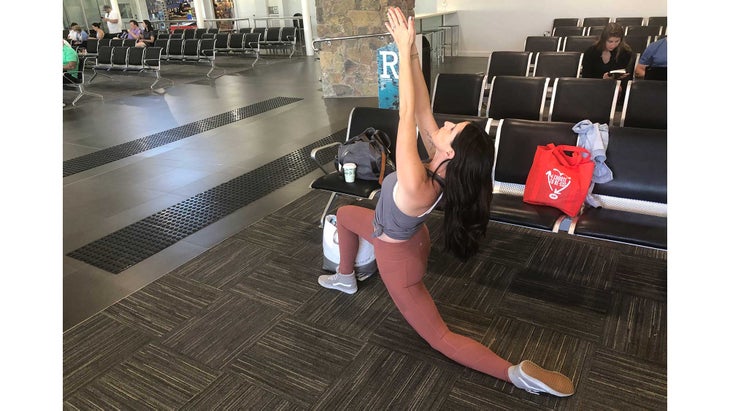
One of the main muscles that gets over-activated and tightens due to stress is the psoas, and Low Lunge is a great way to release this muscle. Because of the psoas’ proximity to the diaphragm, releasing the psoas will also help you breathe easier.
How-to: Start on your hands and knees in a table top position. Step your right foot through your hands and inhale to lift your torso upright. (If you are uncomfortable placing your hands on the floor, step back into a lunge and lower your back knee to the floor instead.) Keep your pelvis lifted off of your front thigh to lengthen your spine and help you isolate your deeper hip flexors (read: the psoas) versus merely stretching your quadriceps. Reach your arms overhead to open your front body even more and to ignite your breath. Stay here for 10-15 breaths, then repeat on the other side.
See also 5 Poses to Help You Reconnect With Your Partner After a Miscommunication
Mountain Pose (Tadasana)
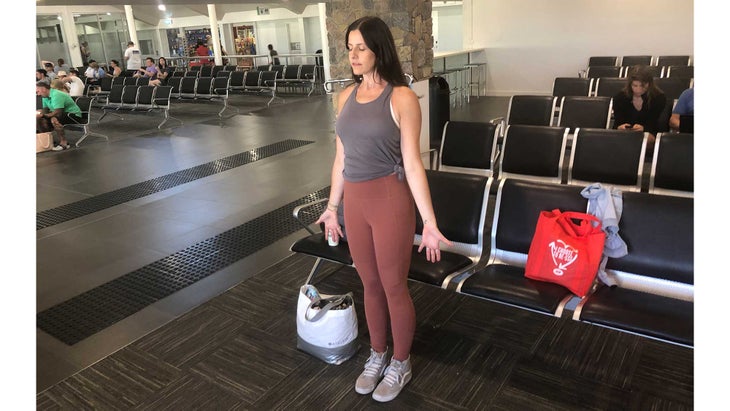
This ultimate standing posture is a great way to get grounded no matter where you are, whether standing on a long security line, waiting to board the plane, or even as you wait for other passengers to board before take-off. Energetically, Tadasana connects us to both the earth beneath us and the heavens above, making it an especially powerful pose for feeling grounded even when you’re about to travel high into the air.
How-to: Stand with your feet together or hip-width distance apart if that feels more stable. Align the center of your heel to your second toe and imagine the arches of your feet are suction cups, drawing energy up from the earth. Firm your legs by gently pulling your knee-caps upward and press your thighs back as you release your tailbone downward. Keep your chest broad and lifted as your front ribs draw inwards to your naval, and keep the back of your neck long, as if the top of your head was tethered to the heavens. If you feel comfortable, allow your eyes to close. Observe your breath in this posture for a minute or longer.
See also 7 Ways to Do Restorative Yoga When You’re Traveling Without Props
About the Author
Sarah Ezrin is a yoga teacher in San Francisco. Learn more at sarahezrinyoga.com.
